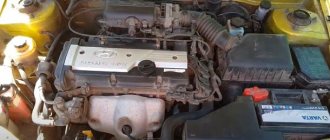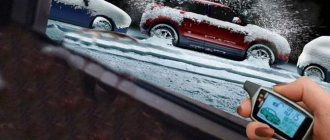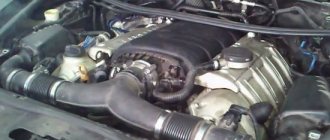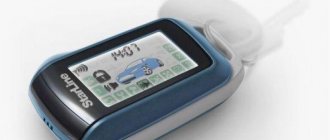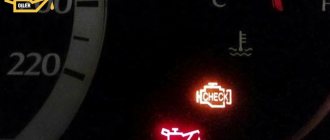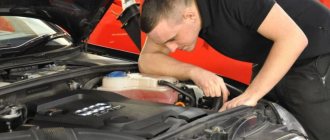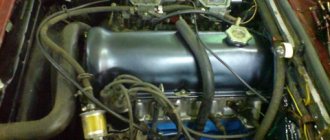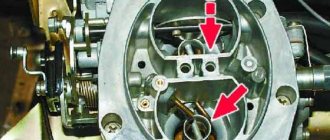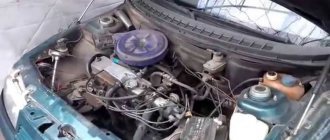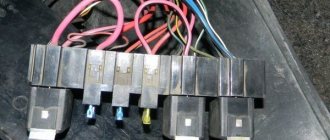There are a great many reasons why the engine does not show signs of life, and sometimes one problem leads to another, and it is immediately difficult to figure out why the car has turned into real estate. We will analyze the most common reasons without touching on the nuances.
Starter.
The starter is a small electric motor that supplies the crankshaft with the torque needed to ignite the fuel.
If after turning the key (or pressing the engine start button) nothing happens or uncharacteristic clicks are heard, then most likely the problem is in the starter. Sometimes it starts working only after several unsuccessful attempts to turn the key, or it turns the engine very slowly, although the battery is charged.
The reasons why the car does not start in this case can be different: from wear of brushes or bearings to oxidized contacts and shorted wiring. On site, you can only check the contacts from the battery, and the battery itself - maybe it is faulty. The rest is best left to specialists. The cost of repair depends on what happened to the starter. It may be possible to repair it or it may have to be replaced entirely.
Generator or battery.
In a nutshell, a generator is a device that converts part of the engine energy into accumulated battery charge. A faulty alternator does not charge (or does not charge enough) the battery, which does not have enough charge to turn the starter. An old battery does not hold a charge well and discharges quickly, especially in cold weather. Usually the problem is one thing at a time.
The battery may be discharged to zero and then the starter will not spin and the instrument panel will not turn on. If there is still voltage, the car will warn you about the low battery with an icon on the instrument panel. The car may start after being “lighted” by another, but you will feel that the generator is charging the battery at half capacity and after parking there is no “current” in the car again.
If the generator breaks down, then the only way is to service. By the way, check the alternator belt if you know where it is located. Perhaps that's the problem. If you see that it has been torn off, order a tow truck. In modern engines, the cooling system operates on this belt and the engine can overheat if you drive under your own power. You can replace the old battery yourself, after first checking the reliability of the contacts on the terminals and the wire line from the generator to the battery.
Spark plug.
The engine may not start due to deposits on the spark plugs, causing them to work incorrectly or not spark at all. This usually happens due to the fault of poor quality fuel. Other options: wear of the electrode or spark plug connector.
Fuel supply system.
The fuel pump may be faulty - burnt out or there are problems with the wiring. By itself, this device rarely breaks down. More often this happens due to the habit of driving “in steam”, filling the tank with the minimum amount. Fuel pumps cool down, “bathing” in fuel, and if there is not enough fuel, they overheat and wear out.
Another reason: the fuel hose is damaged. In this case, the car usually smells like fuel. Sometimes the fuel filter is very clogged, which ceases to be a filter element and turns into a plug.
ECU.
The electronic engine control unit may be faulty, making it impossible to start the engine. This often happens when the ECU box is corroded and the contacts on the board inside are damaged. In some car models, the control unit is structurally poorly located. It begins to rust after a couple of years of use, and then problems begin with starting the engine. The only way to help your car is to take it to a service center for a check. Here we also add problems with the alarm system, which can block the car due to some error.
Since a car is a complex device consisting of many elements, there can be a great many weak points.
We list other possible problems due to which the car may not start:
- insufficient pressure in the cylinders;
- leakage of ignition wires;
- faulty crankshaft, camshaft, idle, oxygen position sensors;
- problems with the timing chain or belt;
- ignition coil malfunction;
- either the fuel simply ran out and you didn’t notice, or the fuel level indicator is lying.
There is no fuel in the car
This is the most common problem faced by millions of car enthusiasts. The fuel level is the first thing you should check, no matter how funny it may sound. After all, you may well not have noticed that the car’s fuel level is at zero. Yes, it may look stupid, but believe me, very often this is the reason the engine fails to start. So if this happens to you, go to the gas station. Here is a simple solution to the problem.
The clamps of the high-voltage wires are loose
The second most common reason for the engine not starting is poor contacts of high-voltage wires with the battery terminals. This occurs due to the fact that the clamps of the high-voltage wires have become loose. So if your car won't start, open the hood and check the tightness of the terminals and their condition. If there is oxidation on them, clean the terminals and then try turning the ignition on again. By the way, the first sign that the terminals have poor contact due to poor tightening is oxidation on them.
Problems with the ignition system
What happens: the starter turns, but the engine doesn’t even catch.
In the absence of a spark, the fuel-air mixture does not ignite and, accordingly, the engine cannot start. The reasons lie in broken ignition coils or wires, as well as spark plugs with a layer of soot or a cracked insulator.
What to do: the easiest way is to unscrew the spark plugs and visually assess the condition of the electrodes: they should be clean and dry. Next, put on the spark plug, attach the spark plug thread to the metal part of the engine and turn it with the starter. If there is a spark, then everything is in order with the ignition. If not, you need to try other spark plugs, and then check the wires and coils, also replacing them with known good ones.
Battery contacts are dirty
If you see some kind of whitish, greenish tint around the battery terminals, then the connection of the high voltage wires to the battery may be weak. Carefully remove the clips from the battery (plate is acidic) and clean the battery terminals with a suitable tool (such as a metal cleaning brush). If you don't have a tool handy, try tapping each battery terminal with a car key of some kind to knock some dirt and residue off the contacts. Then repeat the engine starting process again.
The battery is dead
So, have you checked the high voltage wire clamps, battery terminals and found nothing? Still don't know why your car won't start? Your car's battery is probably dead. If you have wires for "lighting up", you can find another motorist who will agree to help you "light up" your car. If your car was started by another car, have your car's battery diagnosed by a mechanic. It may be time to get a new battery.
Starter does not respond
When you put the key in the ignition (or, in newer cars, press the start button), an electric motor (called the starter) connected to the car's battery turns on your engine to start it. If the starter does not turn, but simply clicks or makes a terrible grinding noise, it’s time to call a tow truck or tow the car to a service center. Most likely the starter has failed.
Starter problems
The starter often fails in cars of any manufacture. He does not have enough strength to spin, and therefore to put the engine into operation. To solve this problem, you need to know all the vulnerabilities of this machine part. The driver needs to check the functionality. The starter on foreign cars is more demanding than on domestic cars.
To troubleshoot, it is recommended to remove it from the car and completely clean the body and fastening elements. Old grease must be carefully removed from the part. This is quite simple to do, but you shouldn’t abuse it. You can check the starter for noise level. If you hear a clicking sound when you try to ignite and it does not turn, then the reason is the relay. Therefore, here you only have to change or repair it. But it should be remembered that the relay is repaired if it is disassembled into its component parts.
The starter is acting up
The most common causes of failure: oxidized and burnt contacts, traction relay frozen due to moisture, wear of brushes and commutator. If the starter is accessible from above, you can simultaneously try to turn on the starter and tap the traction relay with a wrench or hammer (only lightly!). Or close the starter contacts directly. To do this, use a screwdriver to bridge the thick terminal to which the positive wire from the battery goes with a small terminal to which the thin wire goes. If the starter starts to rotate, the starter control circuits (usually the ignition switch) are faulty or are blocked by a faulty alarm system.
If the car has a manual transmission, you can push the engine and drive to the service under your own power. If you have an automatic, look for a tow if the service is close, or call a tow truck.
Starter and ignition switch
You can diagnose the correct operation of the ignition switch in the following way: the key in the ignition switch is turned to the second position. A failure of the ignition switch will be indicated by lights on the control panel that do not light up.
But you can use one more method to check - if the headlights that are turned on when starting the engine begin to dim, this is evidence that the ignition is working properly. If this node turns out to be faulty, the problem can be solved by replacing the switch.
The starter can be seriously damaged by dirt accumulating on it.
You can check it only if you have a tester, and for this you will definitely need a partner. So, the tester should be connected to the starter power wire. At this time, your partner should try to start the engine. If the tester readings indicate the presence of electric current in the circuit, but the starter does not crank, then in this case the starter will definitely have to be replaced.
Attention! During the procedure, try not to touch the exposed wiring with your hands - be sure to use insulating gloves!
What to do if the voltage does not reach the starter
If the headlights continue to burn brightly when you try to start the engine and nothing happens (the starter does not turn), then the voltage is not reaching the starter. This could be due to an open or poorly adjusted emergency park/neutral switch, damaged ignition switch, or faulty starter relay (solenoid). Fuses and fuses are also worth checking, as they could have burned out from overload caused by constant cranking or starting from an external source (“lighting up”).
If the starter clicks when you try to start the engine, but nothing else happens, there may not be enough current to turn the starter. Or maybe the starter has failed
The problem may be a bad battery cable, solenoid or ground, or high resistance of the solenoid itself. Check the voltage at the solenoid to see if battery voltage is passing through the ignition switch circuit. If the solenoid or relay is receiving battery voltage but is not closing its contacts or conducting enough electrical current to turn the starter motor, the solenoid ground may be damaged or the solenoid contacts may be worn, burnt, or corroded.
If the starter turns bypassing the solenoid, it means a new solenoid is needed, not a starter.
Most engines only start at 200 to 300 rpm, so if you have a weak starter that can't get the engine up to speed and provide compression, the engine won't start. In some cases, a weak starter will be able to spin the engine to the required speed, but the engine will still not start, since the starter will take all the battery charge and leave no energy for the injectors or ignition system.
Details on how to drive a manual
When, when trying to start the engine, the headlights dim and the crankshaft does not turn or turns weakly, this may be due to the fact that the starter is jammed, it is slipping or overcoming high internal resistance, its brushes are worn out, or there is a short circuit or break in the windings or armature. Measure the current draw of the starter to see if it is drawing too much current.
The fuel pump relay has failed
When your car stalls and won't start, or if it jerks and chugs when starting, but then the engine still starts, pay attention to the fuel pump. Or the fuel pump relay. True, if you do not understand anything about car repair and diagnostics, you will have to contact a specialist.
Computer diagnostics
If a motor with a working starter does not start, pay attention to the dashboard indicators. When you turn the ignition key, the CHECK, battery, and oil pressure sensor malfunction indicators should light up, and the immobilizer indication should stop. In cars with an injector, after turning the key, you should hear the characteristic sound of the fuel pump pumping - a soft buzzing sound.
If the car does not start with the starter working normally and the tachometer needle does not move, although the electric motor cranks the engine, you need to check the crankshaft sensor. If this element fails, the engine will not be able to start, since permission to do so is not given by the electronic control unit.
To obtain complete information, diagnostic equipment is connected through a special connector, in which the car model and engine type are selected. After connecting to the car’s ECU, the laptop screen will display error codes that are currently relevant. If necessary, you can open a diagram of the car where the area with the breakdown will be localized.
When the starter is working properly, it is necessary to remove several parameters, the failure of which can lead to breakdown:
- The vacuum gauge should show a pressure equal to atmospheric pressure, about 1 bar.
- The specified idle speed must correspond to the characteristics of the engine.
- The engine temperature during cold start should be equal to the ambient temperature.
To track the operating mode of the motor, it is necessary to track its revolutions in real time when the starter rotates, for which there is a special tab in the software. To do this, the starter is started and the crankshaft speed per minute that it provides appears on the screen. The norm is a little more than 200 rpm. If the data remains at zero, the problem is in the crankshaft sensor, which needs to be replaced.
Your car is fine, but the fob/key doesn't work
The reason your engine won't start may have nothing to do with your car at all. It is quite possible that the battery in your key fob has run out. Check your vehicle's manual to find out how to start your car in this situation, or have your dealer diagnose the key/fob (in case the key has failed).
You cannot start the engine because the automatic transmission is in Drive mode.
Another possible reason why your car won't start is if you may be forgetting to put the automatic transmission into Park from Drive or Reverse - R when you turn off the engine. In order to start the engine, move the automatic transmission selector to the “Parking – P” mode and try to start the car again.
Why does the starter turn normally, but the engine does not catch and does not start?
In half the cases when a car refuses to start, the starter is to blame. At the same time, the other half occurs in situations where the starter regularly rotates the crankshaft, but the engine starts only after repeated attempts or is completely silent. This could be due to a variety of reasons.
Driver inattention or negligence
The notorious human factor can manifest itself in the most unexpected ways. For example, a banal lack of fuel or an alarm that blocks the fuel pump. It also happens that some “well-wisher” clogged the exhaust pipe, or a careless driver, while backing up, got stuck in a pile of soil or a snowdrift. Such reasons do not fall into the category of technical malfunctions, but they can spoil a lot of nerves.
Technical problems - starter malfunctions
Every more or less experienced driver will distinguish the sound of a starter, which regularly rotates the engine, from the useless buzz of its electric motor when there is no engagement with the flywheel. When starting to troubleshoot, you should definitely make sure that the starter is functioning normally, and that no extraneous knocks, clicks or malfunctions are observed during its operation.
The candles are filled with gasoline
Modern cars with electronic fuel injection do not require you to pump fuel by pressing the gas pedal before starting the engine. So there is no need to press the gas pedal before starting the injection engine, so as not to fill the spark plugs with gasoline. Otherwise, you may not be able to start the engine. Unfortunately, some drivers forget about this. Especially if you recently switched from a carburetor to an injection car. In general, of course, you can fill the spark plugs on a carburetor engine. But with an injection machine this can be done very quickly. Spark plugs filled with gasoline will not be able to produce a spark when starting the engine to ignite the fuel mixture in the combustion chamber.
Starting the internal combustion engine. How does this happen?
A car engine only works if several conditions are met:
- A sufficient amount of air-fuel mixture enters the cylinders.
- At a certain moment (at the end of the compression stroke), the spark plug generates a spark of the required power.
- The crankshaft and camshaft rotate with strict interaction, ensuring timely filling of the cylinders with the combustible mixture, proper functioning of the gas distribution system and operation of the fuel pump in carburetor internal combustion engines.
By turning the ignition key, the driver supplies power to the starter solenoid relay, which turns on its electric motor and ensures engagement with the crankshaft flywheel ring gear. As the crankshaft rotates, it converts angular momentum into reciprocating motion of the pistons and drives the camshaft (or shafts). The latter ensures timely opening of the valves, due to which the combustion chambers are filled with the fuel mixture at the right time.
The engine power system is responsible for its preparation and delivery. As soon as the piston reaches the top point at the end of the compression stroke, the fine fuel mixture is ignited by the spark formed on the spark plug (in diesel units, ignition occurs due to strong air compression). After this, the micro-explosion acts on the piston, which moves down and causes the crankshaft to rotate - this is what the engine starting diagram looks like.
It's time for a new timing belt
If your engine is silent when you turn the key in the ignition, then it is quite possible that the timing belt has broken. This is a serious problem that you will need a mechanic to fix. The timing belt is the most important engine maintenance item. The fact is that a failed timing belt can lead to engine damage in many cars, resulting in the need for expensive major repairs or even a complete replacement of the engine.
See also: Why change the timing belt
Yes, there are cars where a broken timing belt does not lead to engine damage, but there are fewer such cars than those where belt damage leads to dire consequences. It's all about the valves, which, when the belt breaks, meet the pistons, resulting in damage to both the valves and the pistons. Unfortunately, no matter what type of engine you have, if the belt breaks, you will have to call a tow truck and drag the car to a car repair shop.
Situation three. The car starts and stalls after a few seconds
Is your car having trouble starting? The reasons may vary. It would seem that this is the lesser of two evils - after all, the car starts! But the fact that it immediately stalls can cost a pretty penny...
Compression drop in cylinders
This often occurs at high air humidity. If you have a diesel, then it works a little differently than its gasoline counterpart. Due to the drop in compression, diesel fuel does not ignite, which is a sign of wear on the cylinders and o-rings. I don’t want to upset you, but perhaps the engine is due for a major overhaul...
- Style Dirt as a canvas: artists who turn unwashed cars into art If for you a dirty car is just a dirty car, then you have nothing to do with modern street art. But if glass and body panels covered with dust and streaks of dirt awaken the desire to create, you will be welcome in the still small Dirty Car Art community.
Dirty filters
Let's remember the technical regulations again. This applies to both fuel and air filters. The engine requires clean gasoline to operate properly. Clogged filters do not cope with their main function - preventing dust and dirt from entering the engine. Dirt particles and various impurities prevent gasoline from igniting normally, so the engine starts and immediately stalls.
Pexels
Gasoline pump
Owners of cars with injection engines should read this paragraph. It is quite easy for a person with good hearing to identify problems in the fuel system. In silence, you need to turn the key to the ignition position - a characteristic, quiet buzzing sound should sound. This means the fuel pump is working. Doesn't it buzz? This means that either he died or there was another malfunction in the fuel system. This could be frozen water in the fuel line, a disconnected contact in the circuit, or even a blown fuse. The check should start with the fuse. Didn't it burn out? Then we check the presence of fuel at the Schrader valve. If it is not there, you need to contact a car service - I categorically do not recommend getting into the fuel system yourself.
- Jokes The amazing is nearby: 20 “surprises” that auto mechanics discovered in cars. Get ready to hold your jaw, what you won’t see in car interiors.
Timing chain or belt
This is a fairly non-specific problem in this situation, since problems with the timing belt are difficult to miss. If the car starts and immediately stalls, while you do not have time to move, the belt may have simply fallen off the correct tooth or broken. It's not so sad. It is much worse if a broken belt leads to bending of valves, deformation of connecting rods, and destruction of the cylinder head. In this case, the engine itself will have to be repaired.
Pexels
Less popular reasons
As in the previous situation, when the car does not start well, there may be different reasons - we have listed the most common ones above, but the root of the problem may lie in a malfunction of the following elements:
- Throttle valve (for carburetors). In this case, problems make themselves felt when the engine is cold.
- Oxygen sensor. Unfortunately, this device, also called a lambda probe, cannot be repaired. Replacement required
- Attachments that are “jammed.” This could be the air conditioning compressor, alternator, or power steering pump.
- Crankshaft position sensor (CPS). The on-board computer will probably give an error. The starter will rotate, the car will even be able to start, but it can also stall at any moment
The computer is not working
Modern cars have several high-tech computer gadgets built into them. Computers receive information from various sensors. Including engine malfunctions. If your car does not start, then perhaps some sensor that informed the computer about a problem in the engine caused it to block the start. It is also possible that there are problems with the computer that controls the engine (control unit). In any case, you need to contact a specialist to conduct comprehensive electronic diagnostics of the car.
See also: How to diagnose a car yourself
Generator
A generator is a device that converts part of the engine's energy into electric current, which is also used to charge the battery.
If the generator fails, the battery does not charge at all or is undercharged, resulting in the battery not having enough charge to start the engine.
The best way to solve a problem with a non-working generator is to contact a car service center, where it will be repaired or replaced. You will have to deliver the car to the service station by tow or tow truck.
Seat belts not fastened
Believe it or not, some cars won't start unless the seat belts are securely fastened. Safe, yes, but nevertheless, the owners of such cars are very upset and angry because of such a setting. So before you scold your car for not wanting to start, fasten your seat belts. Your car may be equipped with this unusual feature. By the way, you can disable it by reconfiguring your computer.
You have not disarmed the car, or the steering wheel is not fully unlocked
In many cars, if you do not unlock the steering wheel by inserting the key into the ignition, the engine may not start. In this case, push the steering wheel slightly in any direction while turning the key in the lock. This will unlock the steering wheel and start the engine.
Also, very often, many drivers cannot start the engine without removing the car from the security system. In most cars, when the alarm is on, the ignition interlock works. In this case, remove the car from the alarm system and restart the engine.
Diesel freezing
This is the jelly that forms inside the filter / patch.com
What happens: the engine simply does not start.
Fuel that is not appropriate for the season in diesel cars thickens greatly in the cold. The paraffins included in its composition precipitate, clogging the fine filter and fuel lines. All this causes the engine to not start.
What to do: return the diesel to fluidity. To do this, you need to warm up the car in a warm garage or pour a special antigel additive into the tank. Afterwards, drain or use up the remaining summer fuel and refuel with winter fuel.
Sometimes you can get by with little blood and use a hairdryer to warm up just the fine filter under the hood.
